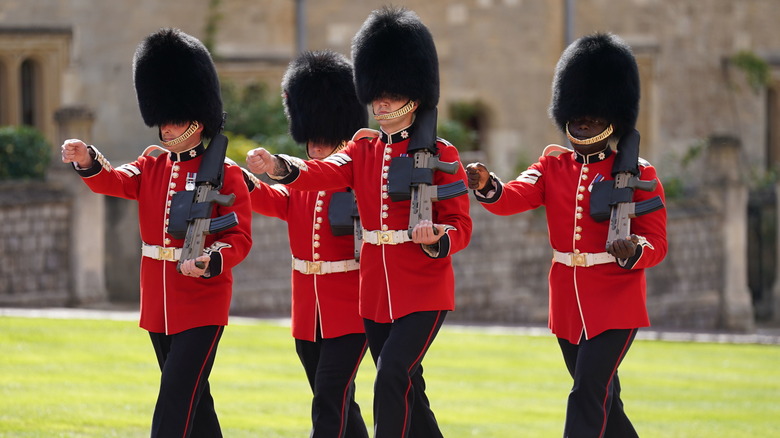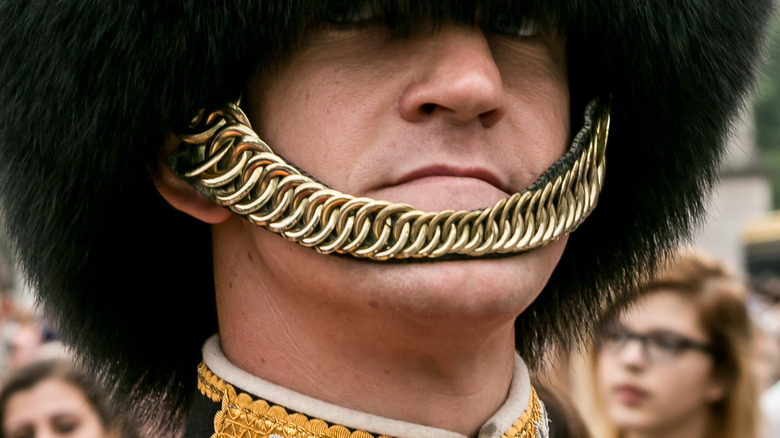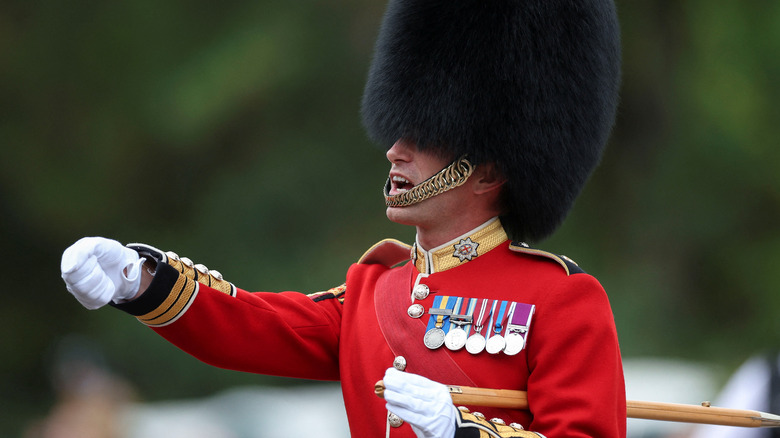The Real Reason British Guards Wear Bearskin Hat Straps Below Their Lips
Known as the queen's foot guards, these special soldiers come from several regiments in the British Army, per City Wonders. They carry out a variety of missions, but they are most commonly recognized for their commanding presence at royal palaces, such as Buckingham Palace. They are easily identifiable because of their red uniforms and towering black bearskin hats, but each regiment puts a slightly different spin on the famous ceremonial garb.
The guards have been a part of British history for more than 360 years, and their distinct ceremonial uniforms are also steeped in history. And believe it or not, the royal guard's current, tall, black bearskin hats were designed to intimidate their enemies by making the soldiers appear physically bigger (via i News). This odd fact is made extra amusing (at least to Brits) because the U.K.'s opponents at the time were the Commonwealth's centuries-old frenemies, the French.
No one less than Napoleon Bonaparte himself deployed grenadiers who wore similar helmets, as British Heritage Travel recounts. Britain's own Grenadier Guards, in a vie to stop Napoleon's continental European advances, donned their own headgear of intimidation and met Napoleon at the famous Battle of Waterloo in 1815. The two nations fought at the famed Battle of Waterloo in 1815 in modern-day Belgium, hat to hat, and the English hat trick worked — or at least, superior tactics won the day. The English came out on top, and the royal guards have donned the fur of black bears on their heads ever since.
The strap style is meant for protection
The Grenadier Guards seen at royal residences and participating in official ceremonies have a unique way of wearing their impressive and statuesque headwear — the strap for the hat is placed under the bottom lip instead of under the chin (via City Wonders). This style may date back to the battlefield and has been influenced by the design of the hat itself.
The hats stand approximately 18 inches tall and weigh around 1.5 pounds, per British Heritage Travel. That's not too, too heavy, but even a small weight gets exceedingly heavy over time, so yes, you need a beefy neck to be a royal guard. The hats are made from the fur of Canadian black bears, and it takes one bear pelt to make one hat. Each pelt costs roughly $751 (£650) and can last for 80 years if cared for properly. The decision to wear the headpiece's chained strap under the lip comes from when soldiers actually fought while wearing them. If a soldier was shot, the hat could fall backward and break his neck, per City Wonders.
Another theory for putting the strap under the lip is that it's a way for one regiment to distinguish themselves from others serving the foot guards (via Leading Britain's Conversation). Whether it's a fashion choice or a form of self-protection, placing the strap under the lip looks pretty uncomfortable. This is one instance where a stiff upper lip is not going to help.
Chin strap, not throat strap
Because the royal guard's hat straps are so conspicuous, discussions about their purpose continue to circulate amongst the public. Beyond preventing soldiers from literally breaking their necks, discussion threads on Quora and Reddit outline other possible functions. Some speculate that the brass rings that compose the strap could have helped deflect sword blows back when they were implemented in 1815. However, because soldiers were more likely to encounter bayonets used for thrusting at the body rather than swords aimed at the cheek, this seems unlikely.
Another pretty reasonable purpose ties in with the hat's size and weight: if the strap was under the chin, it could strangle a guard. "Chin straps" don't go under the chin, in general — that would be a "throat strap." If a guard wearing a tall, bearskin hat was running forward or moving around in actual combat, it makes sense that such motion might drive a throat strap back and right into their windpipe or Adam's apple. So, they're left to suffer the comparatively benign discomfort of a chin strap.
Regardless, at this point, the hats and their design are more of a tradition than anything else. The secret hat-maker (kept secret to not draw the ire of animal rights activists, via British Heritage Travel) just keeps producing them, guards keep wearing them, and that's that. Additionally, the chin straps might just rescue a soldier's bottom teeth if they face plant from exhaustion and "faints to attention," as the Daily Express describes.


